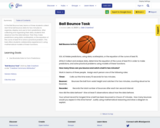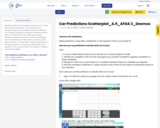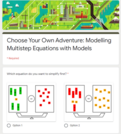
We're Playing Basketball Task Template and Student Version of Task
- Subject:
- Algebra I & II
- Mathematics
- Material Type:
- Lesson Plan
- Provider:
- VDOE
- Author:
- VDOE
- Date Added:
- 10/07/2024

We're Playing Basketball Task Template and Student Version of Task

Solving absolute value equations and inequalities Mathematics Instructional Plans (MIPs) help teachers align instruction with the 2016 Mathematics Standards of Learning (SOL) by providing examples of how the knowledge, skills and processes found in the SOL and curriculum framework can be presented to students in the classroom.

Adding and subtracting polynomialsMathematics Instructional Plans (MIPs) help teachers align instruction with the 2016 Mathematics Standards of Learning (SOL) by providing examples of how the knowledge, skills and processes found in the SOL and curriculum framework can be presented to students in the classroom.

From Khan Academy- This site teaches High Schoolers how to create equations through a series of 298 questions and interactive activities aligned to 5 Common Core mathematics skills.

Exploring sequences and series Mathematics Instructional Plans (MIPs) help teachers align instruction with the 2016 Mathematics Standards of Learning (SOL) by providing examples of how the knowledge, skills and processes found in the SOL and curriculum framework can be presented to students in the classroom.

In the Ball Bounce task, teams of three students collect real-time ball bounce data for two minutes to organize, display and use to form predictions. After collecting and organizing their data, students first observe how the data behave. Then they make predictions using data, scatterplots, or the equation of the curve of best fit to solve a
practical problem. This task offers students collaborative experience in using mathematical models of linear functions.

Calculating mean absolute deviation, variance, and standard deviation Mathematics Instructional Plans (MIPs) help teachers align instruction with the 2016 Mathematics Standards of Learning (SOL) by providing examples of how the knowledge, skills and processes found in the SOL and curriculum framework can be presented to students in the classroom.

Students research two variables about the car model they intend to purchase. They use Desmos to compare these same variables across five different car models. Students use analysis of bivariate data in order to decide which car makes sense to buy. Students prepare and share a summary statement and include desmos screen shots in order to justify their purchase. This task offers students experiences in making predictions, using data, scatterplots, or the equation of the curve of best fit for decision-making in a practical problem.

The cell phone task is open-ended in that it allows students to use multiple solution strategies. Students can create an algebraic inequality or reason through the problem differently. Students can also get different answers (decimal or whole number) as along as they are able to provide reasoning towards their solution.

The cell phone task is open-ended in that it allows students to use multiple solution strategies. Students can create an algebraic inequality or reason through the problem differently. Students can also get different answers (decimal or whole number) as along as they are able to provide reasoning towards their solution.

Students solve multistep equations (with variables on only one side). Students choose between two models/equations at each of six points in this Google Form activity.

This resource from the Mathematics Assessment Project was found at OER Commons. https://www.oercommons.org/courses/finding-equations-of-parallel-and-perpendicular-lines/view. This lesson unit is intended to help teachers assess how well students are able to understand the relationship between the slopes of parallel and perpendicular lines and, in particular, to help identify students who find it difficult to: find, from their equations, lines that are parallel and perpendicular; and identify and use intercepts.

This is a remix of "Comparing Speeds in Graphs and Equations" by Illustrative Mathematics. The activity can be used to introduce the characteristics of direct variations. There is also a link to a direct and inverse variation foldable.

Performing complex number arithmetic Mathematics Instructional Plans (MIPs) help teachers align instruction with the 2016 Mathematics Standards of Learning (SOL) by providing examples of how the knowledge, skills and processes found in the SOL and curriculum framework can be presented to students in the classroom.

This resource includes a Khan Academy video, two truths and a lie activity, and a follow-up review game.

These activities include a video and Desmos activity to help students understand complex numbers.

Exploring Composition of Functions Mathematics Instructional Plans (MIPs) help teachers align instruction with the 2016 Mathematics Standards of Learning (SOL) by providing examples of how the knowledge, skills and processes found in the SOL and curriculum framework can be presented to students in the classroom.

Students evaluate functions to make a connection to compositions of functions. Students then practice finding compositions of functions. Students end the activity evaluating compositions of functions both algebraically and graphically with a challenge that includes multiple compositions.

The lesson provides multiple resources for helping students learn about compound inequalities, how to represent solutions on a number line, and the different types of solutions.

With your mouse, drag data points and their error bars, and watch the best-fit polynomial curve update instantly. You choose the type of fit: linear, quadratic, cubic, or quartic. The reduced chi-square statistic shows you when the fit is good. Or you can try to find the best fit by manually adjusting fit parameters.